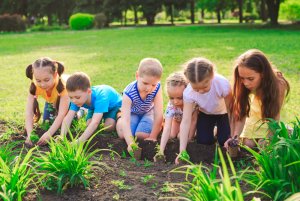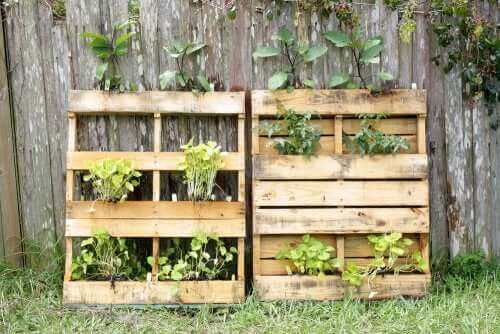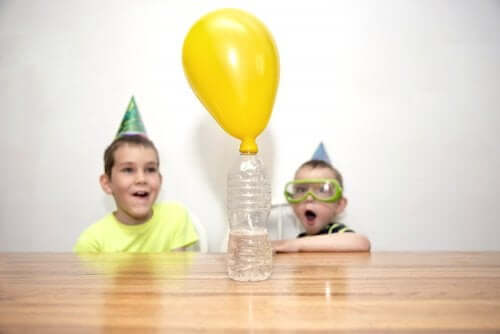Experiments to Teach Children to Care for the Environment


Written and verified by the biologist Olga Carbajo
All children need to learn to respect and care for the environment from the time they are young. Nature provides the food we eat and the oxygen we breathe. Therefore, it’s all of our responsibility to teach children to protect the environment that we all depend on. And, to help you with that, we want to suggest four simple experiments to help children appreciate ecology.
Experiments to teach children to care about the environment: Homemade compost
Compost is a natural fertilizer that we obtain from organic waste. It’s used in gardening and agriculture to fertilize the ground. The process of creating compost – composting – involves the decomposition of organic material that will help to fertilize your garden. So, what materials do you need?
- A plastic jug with a top.
- A bag of dirt (approximately 2 pounds).
- Organic waste from your home.
- Leaves and branches.
Place the jug on your patio or balcony. It’s best to find a place with plenty of air circulation as the decomposition process can be stinky. Add the dirt first, and then the organic waste from your kitchen – things like apple cores and orange peels.
Then, add some leaves and branches you gathered from outdoors. Finally, cover the bottle, but don’t forget to mix it every once in a while. Also, be sure to never add things like leftover meat, fats, or dairy products.
Making an urban garden teaches children to care for the environment
Cultivating your own vegetables and herbs isn’t just gratifying. What’s more, whatever we can grow at home is healthier than what you buy at the store. By making an urban garden, you’ll introduce your children to horticulture and teach them about the growth and development of plants.

If you have limited space, then you can take advantage of a staircase, balcony, or window ledge. Or you can make a vertical garden. The materials you’ll need are the following:
- Two wooden pallets.
- Weed control mesh.
- Dirt.
Place a pallet vertically against a wall and use each of the cross slats to make a box with the wood from the other pallet. Line the base with the control mesh, or with a black garbage bag. Fill it with dirt and you’re ready to go. Now you just need to plant whatever vegetables or herbs you like. We recommend including some aromatic plants that help fend off certain plagues.
As your children build, care for, harvest, and eat from their urban garden, they’ll become more environmentally aware.
How can we “clean” water?
At home, all we need to do is open the faucet and we’ve got clean and fresh drinking water. However, there are areas of the world where that’s not the case. In fact, some people have to walk for miles to get drinking water, and even then it’s not always good quality.
So, we want to suggest this simple experiment so your children can understand how to clean water. At the same time, they’ll understand why it’s so important to care for the environment.
You’ll need the following:
- Two transparent bowls that are the same size.
- A shoebox.
- Faucet water.
- A bit of dirt from your yard.
- A string of yarn that’s about 1 yard long.
Place the box upright, vertically, and place one of the bowls on top with a little bit of water. Then add some dirt to the same bowl.
Set the second bowl at the base of the box and join both bowls with your string. The string will help to separate the components (water and dirt), which will allow you to obtain clean water once again.
One final ecological experiment to teach children to care for the environment
Were you ever tempted, as a child, to see what would happen if you put a mento in a coke bottle? If you’re smiling right now, then you know just what we’re talking about. But here we only suggest safe, controlled and responsible science. And of course, we want you to have fun, too.

In this experiment, we’ll take advantage of the properties of vinegar (acetic acid: C2H4O2) and baking soda (NaHCO3), mixing them together to inflate a balloon. To perform this ecological experiment with your kids, you’ll need the following:
- Safety goggles. If you don’t have any, then the adults in your home should be the one to perform the experience and let your kids observe.
- 1 balloon.
- Half a glass of vinegar.
- One 20 oz. plastic bottle.
- 4 teaspoons of baking soda.
- Paper in order to make a funnel.
- Duct tape.
Pour the vinegar into a bottle, and put the 4 teaspoons of baking powder inside your balloon. Then, attach your balloon to the top of the bottle, but be careful not to let any of the baking powder spill inside. Also, make sure the balloon completely covers the opening of the bottle.
Now, tightly secure the bottle with duct tape and your own hands. Pour the content of the ballon in the bottle and… Did the contents of the bottle heat up?
We hope you and your children have fun with these experiments. But not only that, we hope that these experiments help them to appreciate ecology and learn to take care of the environment.
What is a scientist after all? It is a curious man looking through a keyhole, the keyhole of nature, trying to know what’s going on.
– Jaques Yves Cousteau –
All children need to learn to respect and care for the environment from the time they are young. Nature provides the food we eat and the oxygen we breathe. Therefore, it’s all of our responsibility to teach children to protect the environment that we all depend on. And, to help you with that, we want to suggest four simple experiments to help children appreciate ecology.
Experiments to teach children to care about the environment: Homemade compost
Compost is a natural fertilizer that we obtain from organic waste. It’s used in gardening and agriculture to fertilize the ground. The process of creating compost – composting – involves the decomposition of organic material that will help to fertilize your garden. So, what materials do you need?
- A plastic jug with a top.
- A bag of dirt (approximately 2 pounds).
- Organic waste from your home.
- Leaves and branches.
Place the jug on your patio or balcony. It’s best to find a place with plenty of air circulation as the decomposition process can be stinky. Add the dirt first, and then the organic waste from your kitchen – things like apple cores and orange peels.
Then, add some leaves and branches you gathered from outdoors. Finally, cover the bottle, but don’t forget to mix it every once in a while. Also, be sure to never add things like leftover meat, fats, or dairy products.
Making an urban garden teaches children to care for the environment
Cultivating your own vegetables and herbs isn’t just gratifying. What’s more, whatever we can grow at home is healthier than what you buy at the store. By making an urban garden, you’ll introduce your children to horticulture and teach them about the growth and development of plants.

If you have limited space, then you can take advantage of a staircase, balcony, or window ledge. Or you can make a vertical garden. The materials you’ll need are the following:
- Two wooden pallets.
- Weed control mesh.
- Dirt.
Place a pallet vertically against a wall and use each of the cross slats to make a box with the wood from the other pallet. Line the base with the control mesh, or with a black garbage bag. Fill it with dirt and you’re ready to go. Now you just need to plant whatever vegetables or herbs you like. We recommend including some aromatic plants that help fend off certain plagues.
As your children build, care for, harvest, and eat from their urban garden, they’ll become more environmentally aware.
How can we “clean” water?
At home, all we need to do is open the faucet and we’ve got clean and fresh drinking water. However, there are areas of the world where that’s not the case. In fact, some people have to walk for miles to get drinking water, and even then it’s not always good quality.
So, we want to suggest this simple experiment so your children can understand how to clean water. At the same time, they’ll understand why it’s so important to care for the environment.
You’ll need the following:
- Two transparent bowls that are the same size.
- A shoebox.
- Faucet water.
- A bit of dirt from your yard.
- A string of yarn that’s about 1 yard long.
Place the box upright, vertically, and place one of the bowls on top with a little bit of water. Then add some dirt to the same bowl.
Set the second bowl at the base of the box and join both bowls with your string. The string will help to separate the components (water and dirt), which will allow you to obtain clean water once again.
One final ecological experiment to teach children to care for the environment
Were you ever tempted, as a child, to see what would happen if you put a mento in a coke bottle? If you’re smiling right now, then you know just what we’re talking about. But here we only suggest safe, controlled and responsible science. And of course, we want you to have fun, too.

In this experiment, we’ll take advantage of the properties of vinegar (acetic acid: C2H4O2) and baking soda (NaHCO3), mixing them together to inflate a balloon. To perform this ecological experiment with your kids, you’ll need the following:
- Safety goggles. If you don’t have any, then the adults in your home should be the one to perform the experience and let your kids observe.
- 1 balloon.
- Half a glass of vinegar.
- One 20 oz. plastic bottle.
- 4 teaspoons of baking soda.
- Paper in order to make a funnel.
- Duct tape.
Pour the vinegar into a bottle, and put the 4 teaspoons of baking powder inside your balloon. Then, attach your balloon to the top of the bottle, but be careful not to let any of the baking powder spill inside. Also, make sure the balloon completely covers the opening of the bottle.
Now, tightly secure the bottle with duct tape and your own hands. Pour the content of the ballon in the bottle and… Did the contents of the bottle heat up?
We hope you and your children have fun with these experiments. But not only that, we hope that these experiments help them to appreciate ecology and learn to take care of the environment.
What is a scientist after all? It is a curious man looking through a keyhole, the keyhole of nature, trying to know what’s going on.
– Jaques Yves Cousteau –
All cited sources were thoroughly reviewed by our team to ensure their quality, reliability, currency, and validity. The bibliography of this article was considered reliable and of academic or scientific accuracy.
- Aragón, L., Sánchez, S., & Enríquez, J. M. (2021). El discurso científico en la etapa de infantil en el contexto del huerto ecológico escolar. Revista Eureka sobre Enseñanza y Divulgación de las Ciencias, 18(1), 1103-1103. https://revistas.uca.es/index.php/eureka/article/view/5657/6672
- Carvallo Corral, M. V. (2013). Uso de papel reciclado para Diseño Interior. Cartapesta (Bachelor’s thesis, Universidad del Azuay). https://dspace.uazuay.edu.ec/handle/datos/2596
- Ecohortum. (05 junio 2014). Cómo hacer compost en tu apartamento [reseña en web]. Recuperado de www.ecohortum.com
- Feria de la ciencia. (última consulta julio 2016). Los peque sabios. Recuperado de www.feriadelaciencia.org
This text is provided for informational purposes only and does not replace consultation with a professional. If in doubt, consult your specialist.








